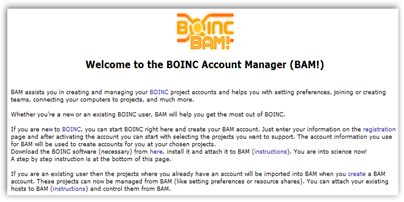I have covered similar items such as the program at Stanford to where you can let  your computer idle power contribute to research. It only runs when your computer is idle and the screensaver comes on. BOINC is a little more involved to where you can again let your computer be used for power or you can join in with projects and contribute some research time!
your computer idle power contribute to research. It only runs when your computer is idle and the screensaver comes on. BOINC is a little more involved to where you can again let your computer be used for power or you can join in with projects and contribute some research time!
Protein Folding – Put your Computer to work for Science during Idle time – Stanford University
Use the idle time on your computer (Windows, Mac, or Linux) to cure diseases, study global warming, discover pulsars, and do many other types of scientific  research. It's safe, secure, and easy:
research. It's safe, secure, and easy:
Or, if you run several projects, try an account manager such as GridRepublic or BAM!.
- Scientists: use BOINC to create a volunteer computing project giving you the computing power of thousands of CPUs.
- Universities: use BOINC to create a Virtual Campus Supercomputing Center.
- Companies: use BOINC for desktop Grid computing.
Open-source software for volunteer computing and grid computing
Below are the current stats so if you are interested in participating you can use the links to read up and get some additional information. With measuring TeraFLOPS you can see they are getting some serious computing power too! BD
Active: 307,470 volunteers, 489,404 computers.
24-hour average: 5,776.06 TeraFLOPS.
John P. Myers is contributing 5,826 GFLOPS.
Country: United States; Team: SETI.USA
Scientific research has an unbounded need for computing power to analyze data and to simulate reality at scales ranging from subatomic to cosmological. David Anderson is working to unlock a new source of computing power: the billions of PCs owned by people around the world. This resource is far more powerful than clouds, grids and
supercomputers, and is nearly free to scientists and funding agencies. Anderson and his team develop a software system called BOINC to support "volunteer computing," in which PC owners can donate their idle time to science projects. BOINC transforms a large set of volunteered computers, which are diverse, un-trusted, and sporadically available, into a trusted and predictable resource for high-throughput scientific computing.
Currently there are over 50 BOINC-based projects doing research in areas ranging from biomedicine to cosmology, with 300,000 active volunteers and 500,000 PCs. This computing power has led to scientific progress of many sorts, including the recent discovery of a new and unusual pulsar, as described in the following NSF press release and an article in Wired News.
Researchers Ask For Help From Your Home Computers | ScienceLives | LiveScience


Tidak ada komentar:
Posting Komentar